Partitioning of Terrain Features Based on Roughness
Abstract
1. Introduction
2. Materials and Methods
2.1. Study Area
2.2. Basic Research Data
3. Research Methods and Models
3.1. Introduction of the Algorithms
- (1)
- Slope (SLOPE), defined as the angle between the tangent plane and horizontal plane at any point on the surface, is one of the most important surface morphological indicators. By calculating the elevation gradient, the Evans algorithm [19] was adopted to calculate the slope in this study.
- (2)
- The local elevation range (RANGE), which is measured as the height deviation within a certain amplitude of distances from the ground [5], is the most common algorithm of topographic relief.
- (3)
- The area ratio (AR) is a commonly used method to measure surface roughness, which is calculated as the ratio of the actual area to the projected area of the surface [3]. In a moving window, the area ratio of each pixel is calculated as the reciprocal of the cosine value of the slope. This principle is based on the triangular relationship between the inclined slope and horizontal projection surface.
- (4)
- The root mean squared height (RMSH) is the most commonly used algorithm to calculate and evaluate roughness, and its parameters are also easy to obtain. RMSH expresses surface roughness as the standard deviation of the elevation of a set of geographic data (Shepard et al., 2001) [2].
- (5)
- The root mean squared deviation (RMSD) is the height difference between two points of a constant lag distance in the local range. In the roughness calculation, the RMSD is the mean square deviation of the height difference between an edge pixel and center pixel in a moving window [2].
- (6)
- The root mean squared slope (RMSS) is another method for calculating roughness based on the mean square root and is defined as the ratio of the mean square deviation of the local elevation to the horizontal distance [2].
- (7)
- The standard deviation of slope (SDS) calculates the standard deviation of the slope and quantifies the roughness of the surface according to the complexity of the changes in the local surface slope [20].
- (8)
- The absolute slope (AS) is similar to the root mean square slope. Both are essentially a deformation of SLOPE [21]. This algorithm can reduce the influence of outliers on the RMSS.
- (9)
- Vector dispersion (VD) can be effectively used to quantify surface roughness based on the spatial variability of the unit direction vector (variability in slope and aspect in local patches of the DEM) [9] (Figure 2). In addition, the variation is measured by calculating the vector strength from the three cosine subvectors of the united orientation vector. The higher the vector intensity, the lower the vector deviation value and the smoother the corresponding ground.
- (10)
- The directional cosine eigenvalue (DCE) shares some similarities with the VD in principle, but the two methods are different. In this algorithm, an orientation matrix is constructed with direction cosines, and the matrix eigenvalue ratio is solved to quantify roughness. The magnitude of the resultant value is positively correlated with the degree of surface smoothness [11].
- (11)
- In recent years, two-dimensional semivariograms (2D SEMs) have been gradually used to measure surface roughness. A 2D SEM can directly show the spatial variation characteristics of regionalized variables and can simultaneously describe the randomness and structure of regionalized variables. The rougher the surface, the greater the spatial difference. In this case, the correlation is quickly lost, and the shorter the lag (space length), the higher the sill (the difference value where points are no longer autocorrelated) [12].
- (12)
- The discrete Fourier transform (2D DFT) is a typical method used to describe surface roughness through spectral analysis [13]. This method transforms discrete data into the frequency domain and provides the distribution characteristics of the amplitude of the terrain in a certain frequency range. The spatial domain can still show different distribution characteristics after being transferred to the frequency domain because of the different surficial spatial domains. For example, flatter terrain features show stronger low-frequency components in the frequency domain, whereas variable terrain shows stronger high-frequency components in the frequency domain. Therefore, it is possible to determine the surface roughness of a particular area by analyzing the characteristic frequencies in the frequency domain.
- (13)
- A two-dimensional continuous wavelet transform (2D CWT) can be used to calculate the energy distribution in the frequency domain using the amplitude information in the spatial domain. This method transforms discrete spatial data into the position–frequency space. The algorithms provide the frequency distribution characteristics of the amplitude information of the terrain at each position in space [13]. This method extracts the high-frequency components of the terrain by selecting a wavelet scale parameter s. When the wavelet scale parameter s is large, it extracts the long wavelength characteristics of the dataset. When the wavelet scale parameter s is small, the short wavelength characteristics of the dataset are extracted. Therefore, by selecting a range of wavelet scale parameters, we could extract the wavelet coefficients of the required characteristic frequency range of surface roughness.
3.2. Roughness Analysis Methods
3.2.1. Spatial Patterns and Structure
3.2.2. Statistical Distribution
3.2.3. Correlation Analysis
3.2.4. Terrain Partition Method
4. Results and Analysis
4.1. Spatial Structure and Pattern
4.1.1. Image Surface Feature
4.1.2. Effect Size and Entropy
4.1.3. Correlation between Algorithms
4.2. Characteristics of the Statistical Distributions
4.2.1. Statistical Distribution
4.2.2. Transformation
4.3. Terrain Partition Based on Roughness
4.3.1. Ability to Distinguish Types of Terrain
4.3.2. Application of Algorithms
5. Discussion and Conclusions
5.1. Discussion
5.2. Conclusions
- (1)
- An ideal roughness algorithm should have the ability to distinguish surface relief (spatial patterns and statistical distributions). From the macro point of view, the 13 algorithms were able to express the spatial variability of the terrain from image surface features to some extent, but there were some differences in their spatial patterns and statistical distributions. In terms of the ability to express and distinguish the terrain, the effect of slope is relatively strong, and the SLOPE algorithm is mature and easy to calculate and distinguishes the four types of terrain in the study area. The statistical distribution characteristics of these four types of terrain had a single peak distribution according to the slope algorithm. The seven roughness algorithms that had a high slope correlation were RANGE, AR, RMSH, RMSD, RMSS, AS, and 2D SEM, and the results of RMSH were the best in terms of the spatial pattern, statistical distribution, and ability to distinguish terrain types. The advantage of the algorithms based on spectral analysis was that they could quantify different terrain patterns according to different frequency bands and had an equivalent ability to partition terrain as the slope-based methods after canonical transformation. SDS, DCE, and VD have the general ability to distinguish terrain and can only classify two types of terrain.
- (2)
- In terms of applicability, the SLOPE algorithm could directly reflect the degree of steepness and irregularity of the surface unit. Among several algorithms having high correlation with SLOPE, RANGE could express the undulation of terrain over a relatively wide range of heights, and RMSH focused on expressing the degree of discreteness of the terrain. These algorithms could distinguish terrain well. SDS, DCE, and VD were not suitable for distinguishing terrain features, as the former algorithm is used to represent the complexity of slope variation in local areas, whereas the latter two are more suited for the extraction of terrain features at a fine scale. Two algorithms based on spectral analysis could be used to extract the required frequency components by adjusting the range of characteristic frequencies. Although the obtained spectral parameters could not be directly transformed into roughness indexes, and there was no clear and intuitive roughness meaning, the advantage was that they can quantify different topographic patterns and features according to the spatial characteristics of the frequency distribution.
Author Contributions
Funding
Acknowledgments
Conflicts of Interest
References
- Hani, A.F.M.; Sathyamoorthy, D.; Asirvadam, V.S. A method for computation of surface roughness of digital elevation model terrains via multiscale analysis. Comput. Geosci. 2011, 37, 177–192. [Google Scholar] [CrossRef]
- Shepard, M.K.; Campbell, B.A.; Bulmer, M.H.; Farr, T.G.; Gaddis, L.R.; Plaut, J.J. The roughness of natural terrain: A planetary and remote sensing perspective. J. Geophys. Res. Planets 2001, 106, 32777–32795. [Google Scholar] [CrossRef]
- Grohmann, C.H.; Smith, M.J.; Riccomini, C. Multiscale analysis of topographic surface roughness in the midland valley, scotland. IEEE Trans. Geosci. Remote Sens. 2011, 49, 1200–1213. [Google Scholar] [CrossRef]
- Lv, Y.L.; Li, G.Y. Surface roughness and soil wind erosion. Adv. Soil Sci. 1992, 38–42. [Google Scholar]
- Lawless, M.; Robert, A. Scales of boundary resistance in coarse-grained channels: Turbulent velocity profiles and implications. Geomorphology 2001, 39, 221–238. [Google Scholar] [CrossRef]
- Lacey, R.W.J.; Roy, A.G. The spatial characterization of turbulence around large roughness elements in a gravel-bed river. Geomorphology 2008, 102, 542–553. [Google Scholar] [CrossRef]
- Jester, W.; Klik, A. Soil surface roughness measurement—Methods, applicability, and surface representation. Catena 2005, 64, 174–192. [Google Scholar] [CrossRef]
- Smith, M.W. Roughness in the earth sciences. Earth-Sci. Rev. 2014, 136, 202–225. [Google Scholar] [CrossRef]
- Hobson, R.D. Surface Roughness in Topography: Quantitative Approach. In Spatial Analysis in Geomorphology; Methuen & Co.: London, UK, 1972; pp. 221–245. [Google Scholar]
- Hoffman, R.; Krotkov, E. Terrain roughness measurement from elevation maps. Int. Soc. Optics Photon. 1990, 4, 104–114. [Google Scholar] [CrossRef]
- Mckean, J.; Roering, J. Objective landslide detection and surface morphology mapping using high-resolution airborne laser altimetry. Geomorphology 2004, 57, 331–351. [Google Scholar] [CrossRef]
- Glenn, N.F.; Streutker, D.R.; Chadwick, D.J.; Thackray, G.D.; Dorsch, S.J. Analysis of lidar-derived topographic information for characterizing and differentiating landslide morphology and activity. Geomorphology 2006, 73, 131–148. [Google Scholar] [CrossRef]
- Booth, A.M.; Roering, J.J.; Perron, J.T. Automated landslide mapping using spectral analysis and high-resolution topographic data: Puget sound lowlands, washington, and portland hills, oregon. Geomorphology 2009, 109, 132–147. [Google Scholar] [CrossRef]
- Pommerol, A.; Chakraborty, S.; Thomas, N. Comparative study of the surface roughness of the moon, mars and mercury. Planet. Space Sci. 2012, 73, 287–293. [Google Scholar] [CrossRef]
- Berti, M.; Corsini, A.; Daehne, A. Comparative analysis of surface roughness algorithms for the identification of active landslides. Geomorphology 2013, 182, 1–18. [Google Scholar] [CrossRef]
- Lane, S.N. Roughness—Time for a re-evaluation? Earth Surf. Process. Landf. 2010, 30, 251–253. [Google Scholar] [CrossRef]
- Moore, I.D.; Grayson, R.B.; Ladson, A.R. Digital terrain modelling: A review of hydrological, geomorphological, and biological applications. Hydrol. Process. 2010, 5, 3–30. [Google Scholar] [CrossRef]
- Jiang, H.S.; Yang, Q.K. Algorithm comparison of relief amplitude based on dynamic effect mode. Bull. Soil Water Conserv. 2014, 34, 162–166. [Google Scholar] [CrossRef]
- Evans, I.S. An integrated system of terrain analysis and slope mapping. Zeitschrift für Geomorphologie 1980, 36, 274–295. [Google Scholar]
- Frankel, K.L.; Dolan, J.F. Characterizing arid region alluvial fan surface roughness with airborne laser swath mapping digital topographic data. J. Geophys. Res. Earth Surf. 2007, 112, 325–327. [Google Scholar] [CrossRef]
- Kreslavsky, M.A.; III, J.W.H. Kilometer-scale slopes on mars and their correlation with geologic units: Initial results from mars orbiter laser altimeter (mola) data. J. Geophys. Res. Planets 1999, 104, 21911–21924. [Google Scholar] [CrossRef]
- Cohen, J. Statistical Power Analysis for the Behavioral Sciences; L. Lawrence Earlbaum Associates: Hillsdale, NJ, USA, 1988; Volume 2. [Google Scholar]
- Shannon, C.E. A mathematical theory of communication: The bell system technical journal. J. Frankl. Inst. 1938, 196, 519–520. [Google Scholar]
- Box, G.E.P.; Cox, D.R. An analysis of transformations. J. R. Stat. Soc. 1964, 26, 211–252. [Google Scholar] [CrossRef]
- Csillik, O.; Evans, I.S.; Drăguţ, L. Transformation (normalization) of slope gradient and surface curvatures, automated for statistical analyses from dems. Geomorphology 2015, 232, 65–77. [Google Scholar] [CrossRef]
- Wolinsky, M.A.; Pratson, L.F. Constraints on landscape evolution from slope histograms. Geology 2005, 33, 477–480. [Google Scholar] [CrossRef]
- Bretar, F.; Arab-Sedze, M.; Champion, J.; Pierrot-Deseilligny, M.; Heggy, E.; Jacquemoud, S. An advanced photogrammetric method to measure surface roughness: Application to volcanic terrains in the piton de la fournaise, reunion island. Remote. Sens. Environ. 2013, 135, 1–11. [Google Scholar] [CrossRef]
- Jiang, Y.C.; Fang, H.L.; Wei, S.S. Review of land surface roughness parameterization studyreview of land surface roughness parameterization study. Adv. Earth Sci. 2012, 27, 292–303. [Google Scholar]
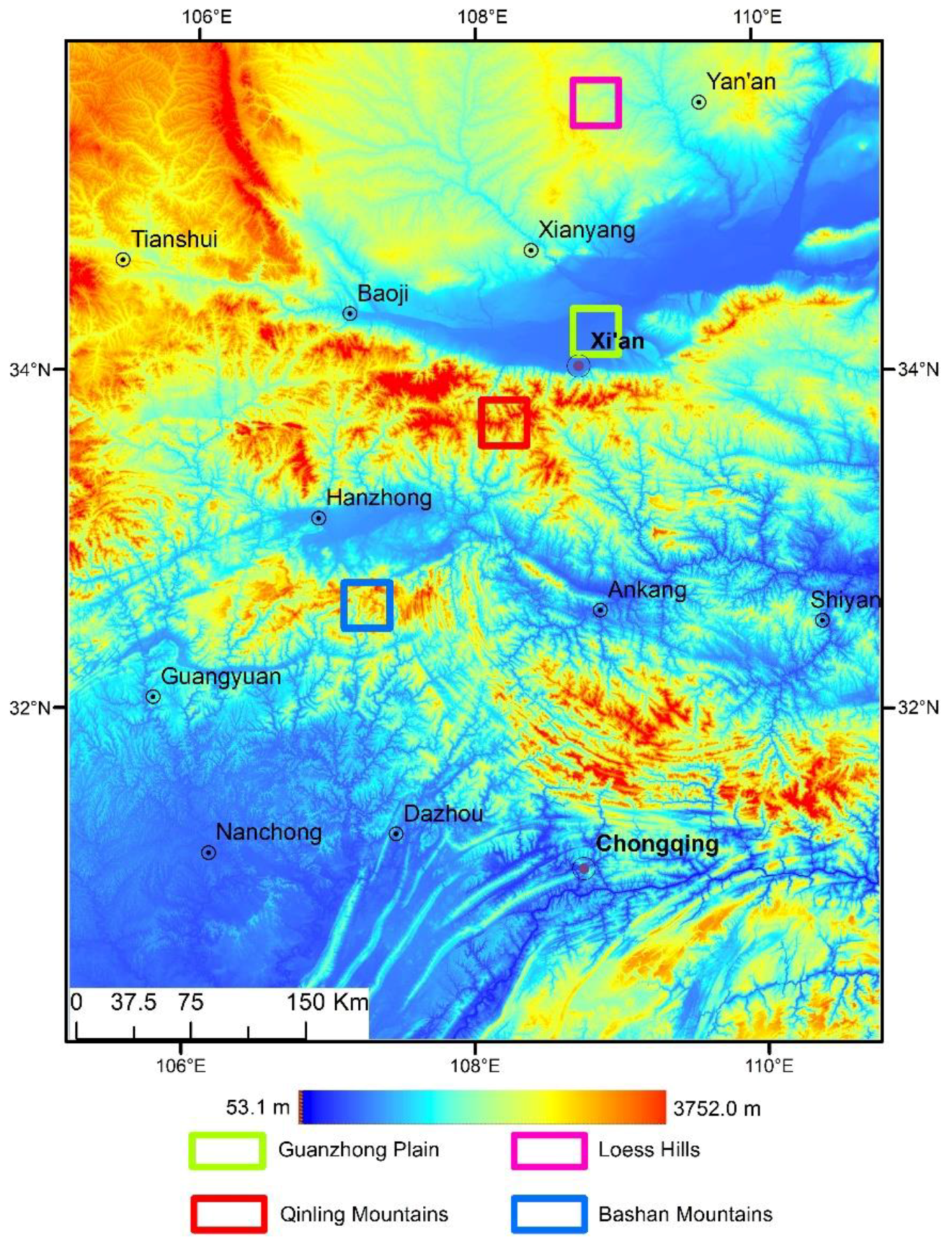

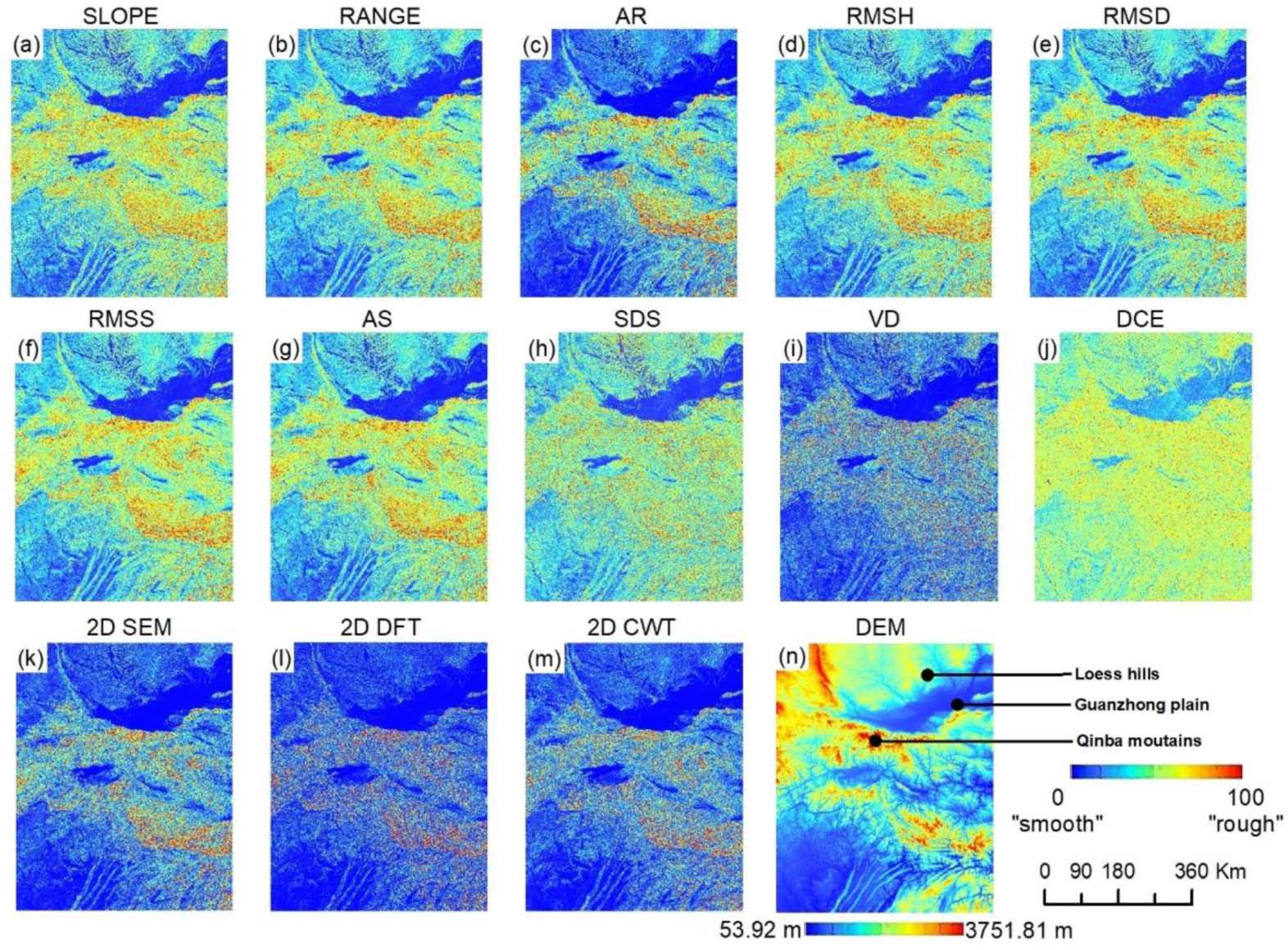
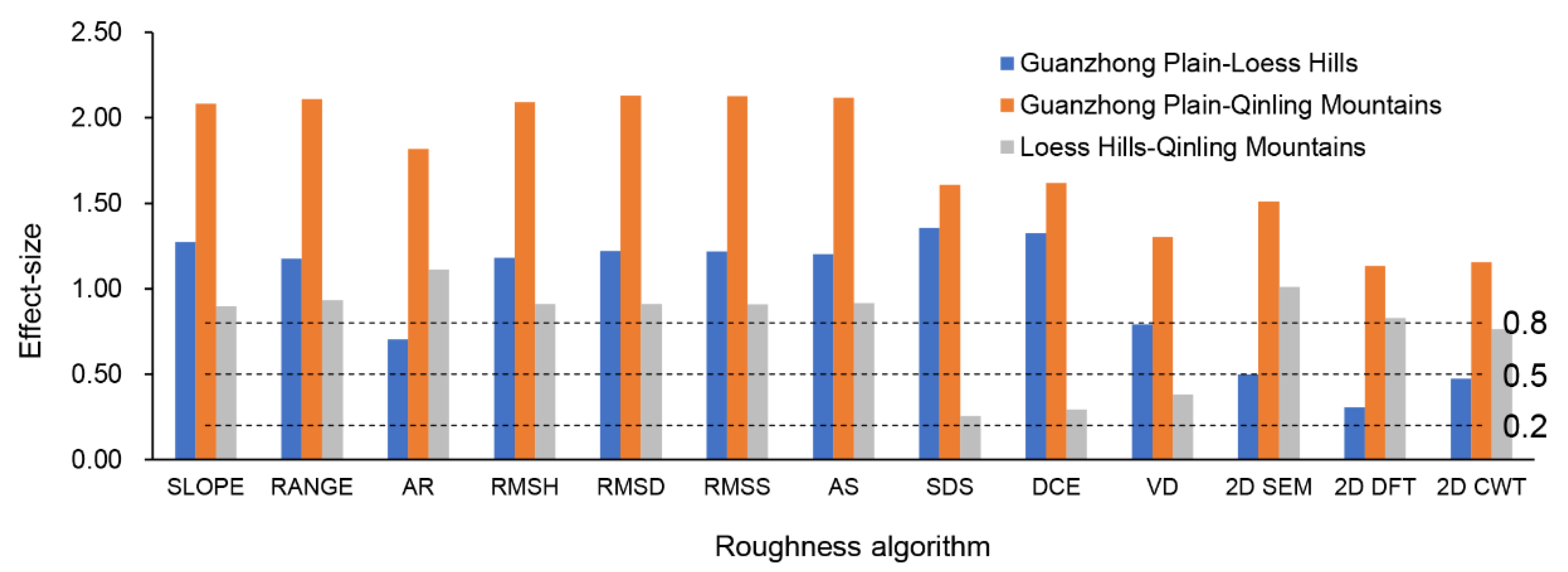
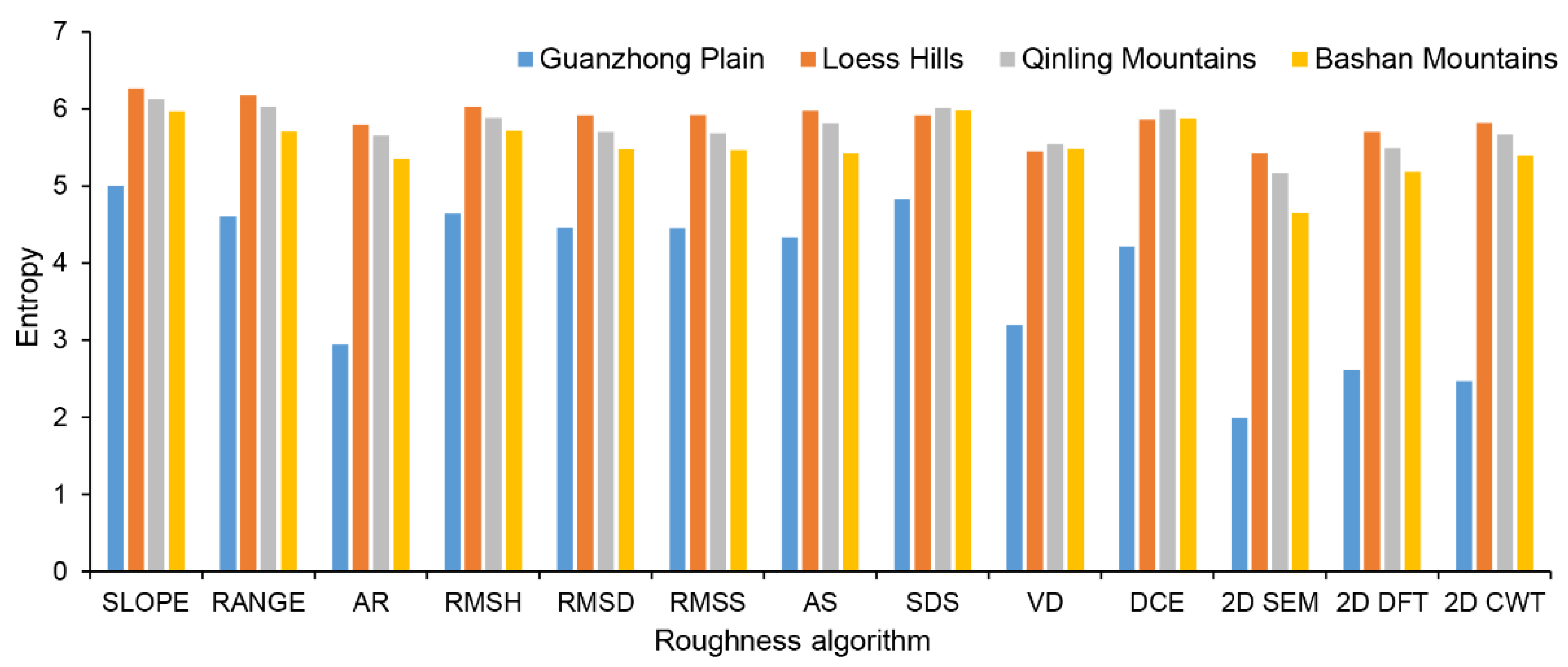
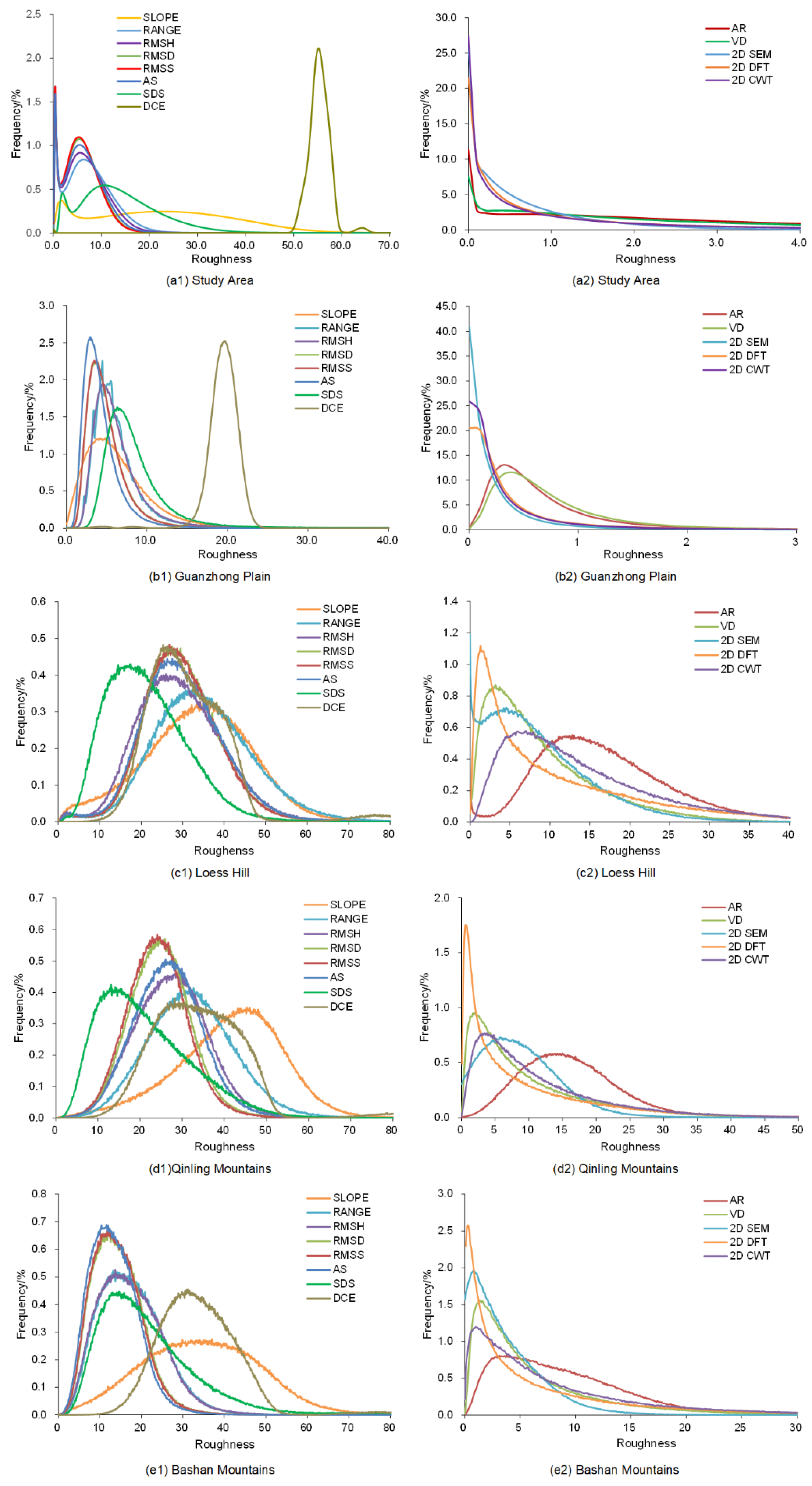
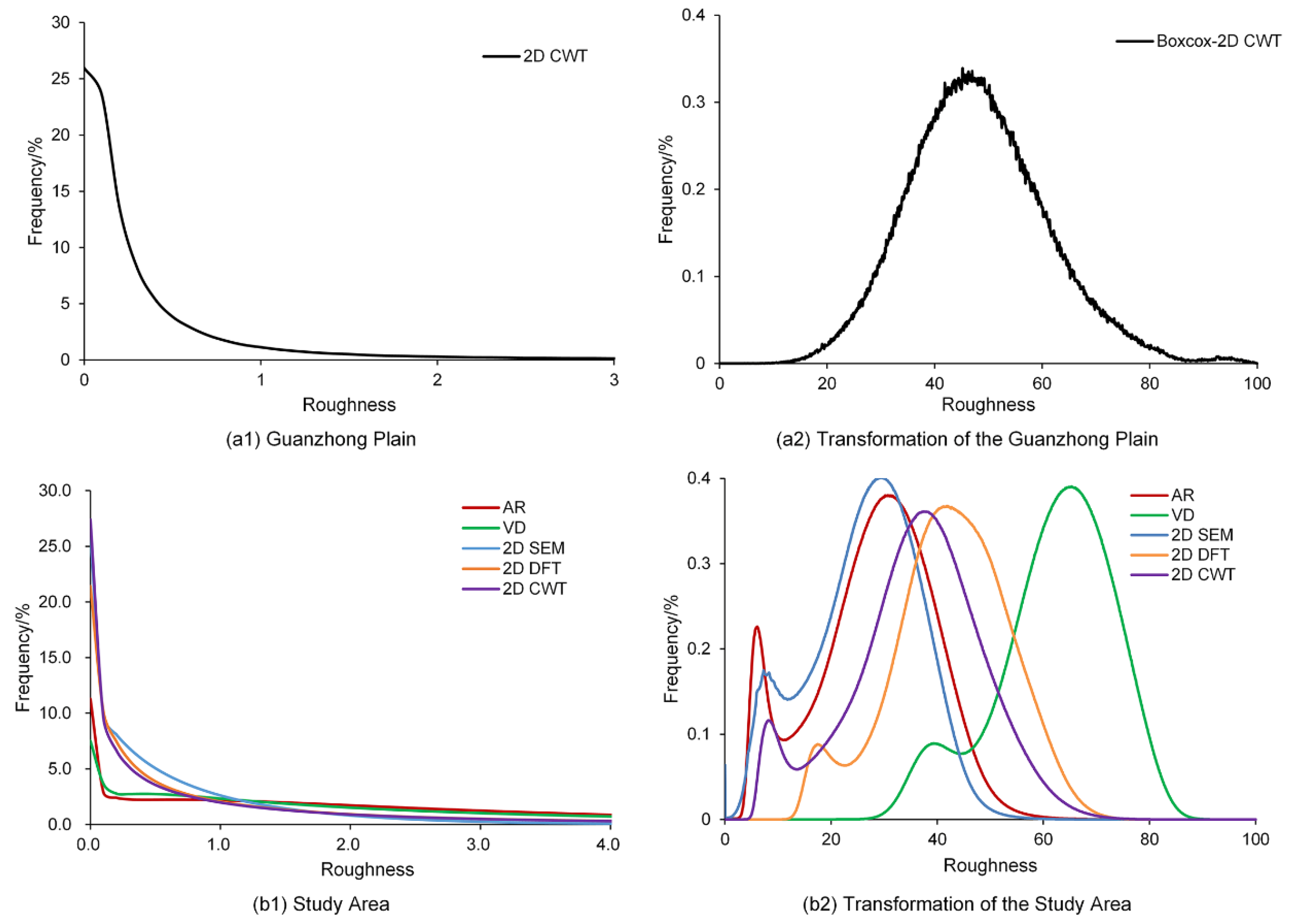
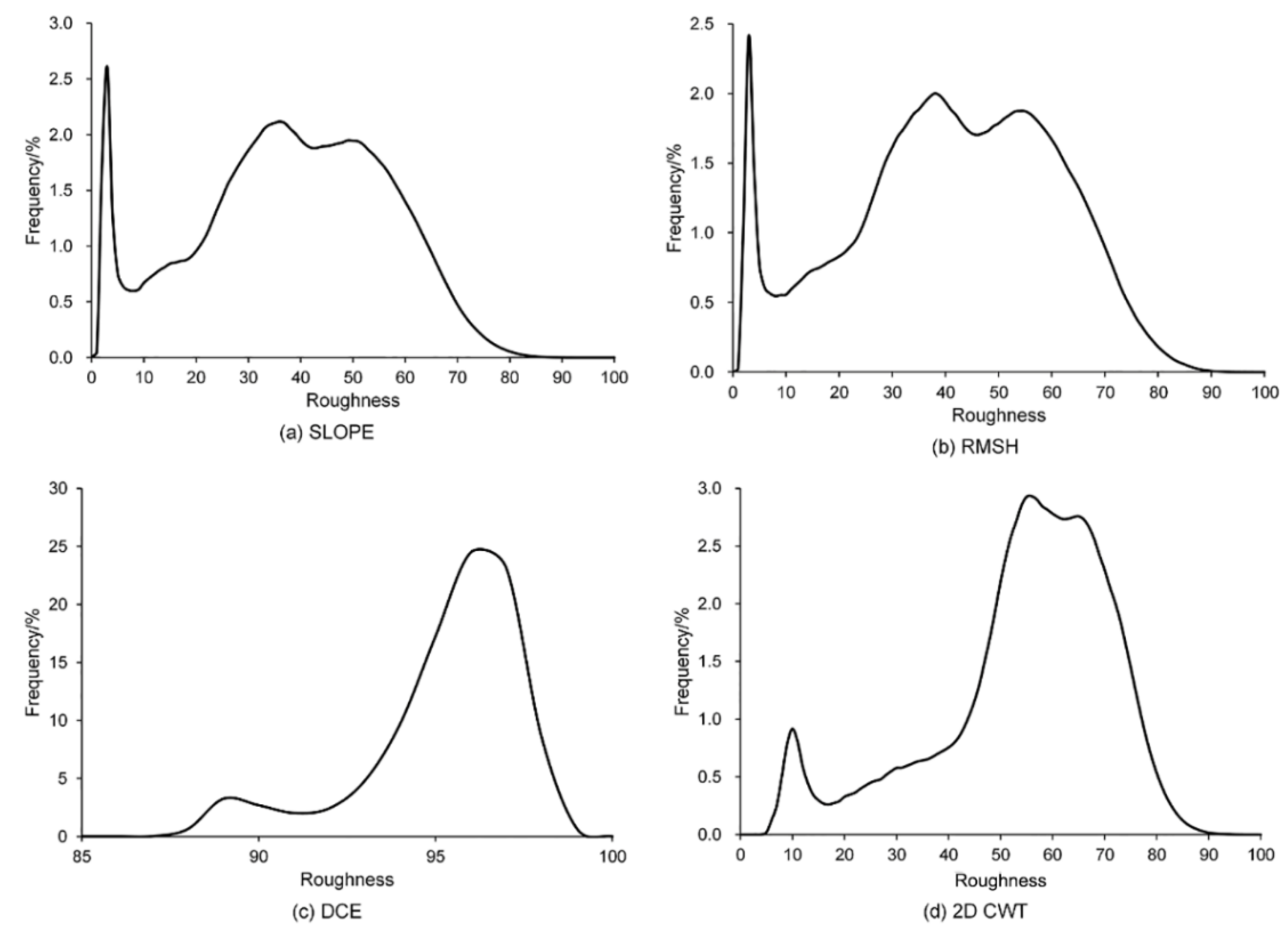
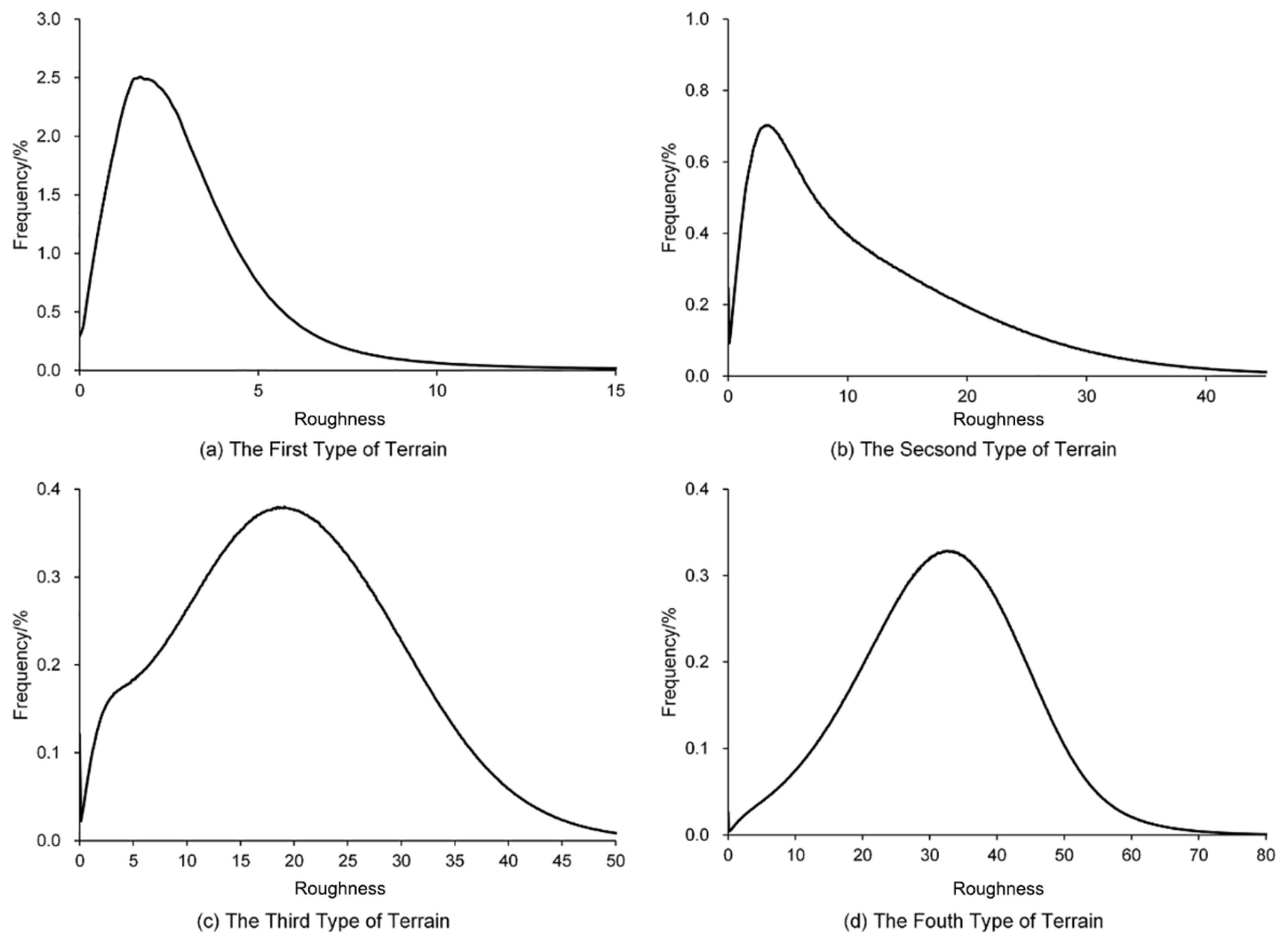
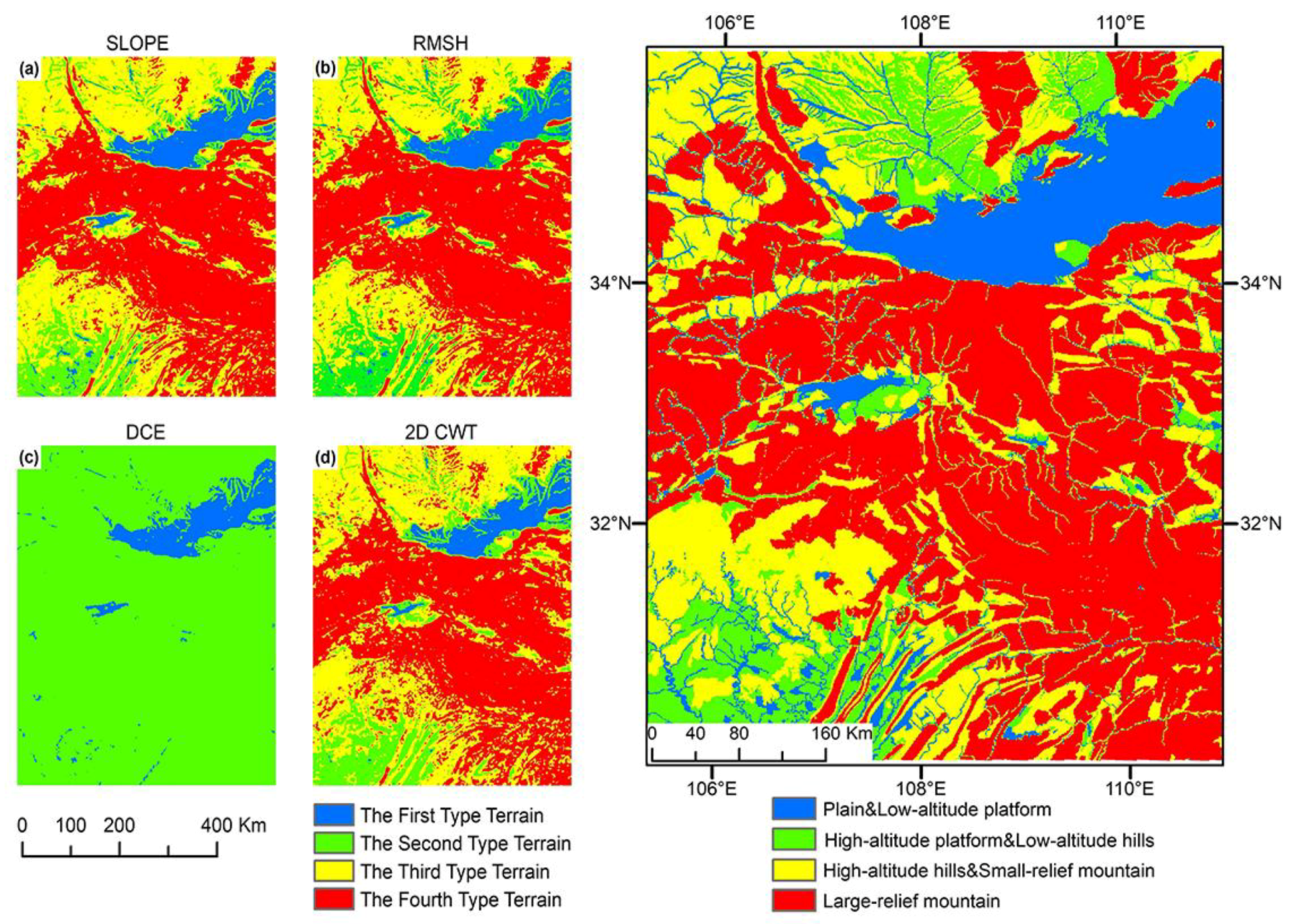
| Sequence Number | Algorithms (ALG) | Formula | Dimension |
|---|---|---|---|
| 1 | Slope (SLOPE) | Degree | |
| 2 | Local Elevation Range (RANGE) | m | |
| 3 | Area Ratio (AR) | None | |
| 4 | Root Mean Squared Height (RMSH) | m | |
| 5 | RMS Deviation (RMSD) | m | |
| 6 | RMS Slope (RMSS) | Degree | |
| 7 | Absolute Slope (AS) | Degree | |
| 8 | Standard Deviation of Slope (SDS) | Degree | |
| 9 | Vector Dispersion (VD) | None | |
| 10 | Direction Cosine Eigenvalue (DCE) | None | |
| 11 | 2D Semivariogram (2D SEM) | m2 | |
| 12 | Discrete Fourier Transform (2D DFT) | m2 | |
| 13 | Continuous Wavelet Transform (2D CWT) | m2 |
| ALG | Effect Size | |||||
|---|---|---|---|---|---|---|
| Guanzhong Plain–Loess Hills | Guanzhong Plain–Qinling Mountains | Guanzhong Plain–Bashan Mountains | Loess Hills–Qinling Mountains | Loess Hills–Bashan Mountains | Qinling Mountains–Bashan Mountains | |
| SLOPE | 1.273 | 2.083 | 1.837 | 0.899 | 0.645 | 0.245 |
| RANGE | 1.175 | 2.109 | 1.853 | 0.934 | 0.678 | 0.257 |
| AR | 0.703 | 1.816 | 1.542 | 1.113 | 0.839 | 0.274 |
| RMSH | 1.181 | 2.092 | 1.845 | 0.911 | 0.664 | 0.247 |
| RMSD | 1.220 | 2.131 | 1.882 | 0.911 | 0.661 | 0.250 |
| RMSS | 1.218 | 2.126 | 1.877 | 0.909 | 0.660 | 0.249 |
| AS | 1.203 | 2.118 | 1.863 | 0.916 | 0.661 | 0.255 |
| SDS | 1.355 | 1.609 | 1.637 | 0.254 | 0.282 | 0.028 |
| DCE | 1.325 | 1.619 | 1.548 | 0.294 | 0.223 | 0.071 |
| VD | 0.792 | 1.302 | 1.084 | 0.427 | 0.262 | 0.218 |
| 2D SEM | 0.499 | 1.509 | 1.293 | 1.010 | 0.794 | 0.216 |
| 2D DFT | 0.306 | 1.134 | 0.965 | 0.828 | 0.659 | 0.169 |
| 2D CWT | 0.473 | 1.155 | 1.139 | 0.762 | 0.666 | 0.016 |
| ALG | SLOPE | RANGE | AR | RMSH | RMSD | RMSS | AS | SDS | DCE | VD | 2D SEM | 2D DFT | 2D CWT |
|---|---|---|---|---|---|---|---|---|---|---|---|---|---|
| SLOPE | 1.0000 | ||||||||||||
| RANGE | 0.9420 | 1.0000 | |||||||||||
| AR | 0.8655 | 0.9420 | 1.0000 | ||||||||||
| RMSH | 0.9671 | 0.9871 | 0.9491 | 1.0000 | |||||||||
| RMSD | 0.9403 | 0.9804 | 0.9542 | 0.9897 | 1.0000 | ||||||||
| RMSS | 0.9442 | 0.9792 | 0.9540 | 0.9905 | 0.9997 | 1.0000 | |||||||
| AS | 0.9447 | 0.9764 | 0.9510 | 0.9907 | 0.9958 | 0.9959 | 1.0000 | ||||||
| SDS | 0.4573 | 0.4791 | 0.4630 | 0.4870 | 0.5411 | 0.5396 | 0.4953 | 1.0000 | |||||
| VD | 0.2590 | 0.3268 | 0.3757 | 0.3129 | 0.4070 | 0.4029 | 0.3681 | 0.7383 | 1.0000 | ||||
| DCE | 0.3366 | 0.3573 | 0.3112 | 0.3519 | 0.3950 | 0.3928 | 0.3757 | 0.5508 | 0.5191 | 1.0000 | |||
| 2D SEM | 0.8191 | 0.8950 | 0.9466 | 0.9034 | 0.8834 | 0.8826 | 0.8889 | 0.2864 | 0.1813 | 0.1155 | 1.0000 | ||
| 2D DFT | 0.2833 | 0.3191 | 0.3439 | 0.3179 | 0.3444 | 0.3426 | 0.3272 | 0.4274 | 0.2567 | 0.4069 | 0.2493 | 1.0000 | |
| 2D CWT | 0.2693 | 0.3055 | 0.3285 | 0.3014 | 0.3334 | 0.3312 | 0.3148 | 0.4471 | 0.2781 | 0.4572 | 0.2164 | 0.9013 | 1.0000 |
| Alg | Study Area | The First Type of Terrain | The Second Type of Terrain | The Third Type of Terrain | The Fourth Type of Terrain |
|---|---|---|---|---|---|
| SLOPE | 0.682 | 0.609 | 0.407 | 0.561 | 0.814 |
| RMSH | 0.680 | 0.589 | 0.421 | 0.562 | 0.824 |
| 2D CWT | 0.637 | 0.502 | 0.408 | 0.617 | 0.863 |
© 2018 by the authors. Licensee MDPI, Basel, Switzerland. This article is an open access article distributed under the terms and conditions of the Creative Commons Attribution (CC BY) license (http://creativecommons.org/licenses/by/4.0/).
Share and Cite
Wu, J.; Yang, Q.; Li, Y. Partitioning of Terrain Features Based on Roughness. Remote Sens. 2018, 10, 1985. https://doi.org/10.3390/rs10121985
Wu J, Yang Q, Li Y. Partitioning of Terrain Features Based on Roughness. Remote Sensing. 2018; 10(12):1985. https://doi.org/10.3390/rs10121985
Chicago/Turabian StyleWu, Jiang, Qinke Yang, and Yuru Li. 2018. "Partitioning of Terrain Features Based on Roughness" Remote Sensing 10, no. 12: 1985. https://doi.org/10.3390/rs10121985
APA StyleWu, J., Yang, Q., & Li, Y. (2018). Partitioning of Terrain Features Based on Roughness. Remote Sensing, 10(12), 1985. https://doi.org/10.3390/rs10121985





